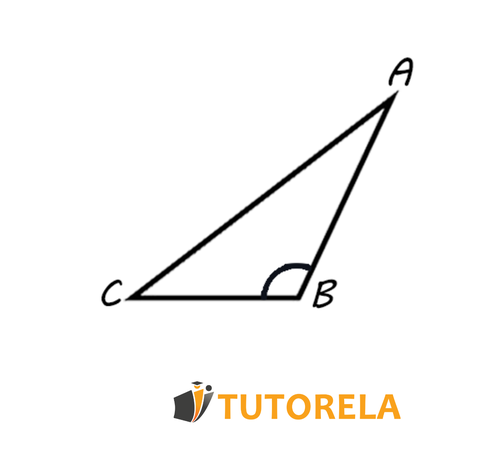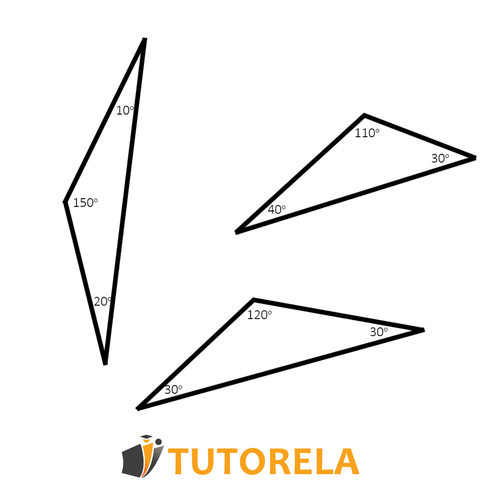An obtuse triangle is a triangle that has one obtuse angle (greater than degrees and less than degrees) and two acute angles (each of which is less than degrees). The sum of all three angles together is degrees.
Obtuse Triangle
Test yourself on types of triangles!
Is the triangle in the drawing a right triangle?
Next, we will look at some examples of obtuse triangles:
Obtuse triangle

Examples of obtuse triangles

Exercises with Obtuse Triangles
Exercise 1
Homework:
Calculate which is larger
Given that the triangle is an obtuse triangle.
Which angle is larger or ?
Solution:
Since we are given that the triangle is an obtuse triangle, we understand that is not greater than .
In a triangle, there is only one obtuse angle therefore the answer is:
Answer:
In a right triangle, the sum of the two non-right angles is...?
Given the values of the sides of a triangle, is it a triangle with different sides?
Is the triangle in the drawing a right triangle?
Exercise 2
Given the triangle .
is obtuse.
The sum of the acute angles in the triangle is equal to .
Find the value of angle .
Solution:
Since we know that is obtuse, we are certain that angles and are acute.
This means that we have the information that the sum of the acute angles
The sum of the angles in a triangle is equal to .
Answer:
Exercise 3
Given the obtuse triangle .
,
Task:
Is it possible to calculate ?
If so, calculate it.
Solution:
Given that:
We substitute:
Answer: yes, .
Choose the appropriate triangle according to the following:
Angle B equals 90 degrees.
In a right triangle, the two sides that form a right angle are called...?
In a right triangle, the side opposite the right angle is called....?
Exercise 4
Assignment
Which triangle is given in the drawing?
Solution
Since angles and : are both equal to , we know that the opposite sides are also equal, therefore the triangle is isosceles.
Answer
Isosceles triangle
Exercise 5
Assignment
Determine which of the following triangles is obtuse, which is acute, and which is right:
Solution
Let's observe triangle and check if it satisfies the Pythagorean theorem, therefore we replace the data we have:
We solve the equation
The sum of the squares of the "perpendicular" is greater than the square of the rest, therefore the triangle is an isosceles triangle.
Let's observe triangle and check if it satisfies the Pythagorean theorem, therefore we replace the data we have:
We solve the equation
The sum of the squares of the "perpendicular" is less than the square of the other, therefore the triangle is obtuse
Let's observe triangle and check if the Pythagorean theorem is satisfied, first we calculate what is the square root of
This is the largest side among the: and we will refer to it as "hypotenuse".
Now we replace the data we have:
We solve the equation
In this triangle, the Pythagorean theorem is satisfied and therefore the triangle is right.
Answer
A: acute angle B: obtuse angle C: right angle
Fill in the blanks:
In an isosceles triangle, the angle between two ___ is called the "___ angle".
In an isosceles triangle, the angle between ? and ? is the "base angle".
In an isosceles triangle, the third side is called?
Examples with solutions for Obtuse Triangle
Exercise #1
Is the triangle in the drawing an acute-angled triangle?
Video Solution
Step-by-Step Solution
An acute-angled triangle is defined as a triangle where all three interior angles are less than .
In examining the visual depiction of the triangle provided in the problem, we need to see if it appears to satisfy this property. The assessment relies on observing the triangle's structure shown in the drawing and noting any geometric indications suggesting angle types.
Given the information from the drawing, if all angles seem to satisfy the condition of being less than , then by definition, the triangle is an acute-angled triangle.
Conclusively, the answer to whether the triangle is acute-angled based on provided visual assessment and inherent assumptions in its illustration is: Yes.
Answer
Yes
Exercise #2
In an isosceles triangle, the angle between ? and ? is the "base angle".
Step-by-Step Solution
An isosceles triangle is one that has at least two sides of equal length. The angles opposite these two sides are known as the "base angles."
The side that is not equal to the other two is referred to as the "base" of the triangle. Thus, the "base angles" are the angles between each of the sides that are equal in length and the base.
Therefore, when we specify the angle in terms of its location or position, it is the angle between a "side" and the "base." This leads to the conclusion that the angle between the side and the base is the "base angle."
Therefore, the correct choice is Side, base.
Answer
Side, base.
Exercise #3
Given the values of the sides of a triangle, is it a triangle with different sides?
Video Solution
Step-by-Step Solution
As is known, a scalene triangle is a triangle in which each side has a different length.
According to the given information, this is indeed a triangle where each side has a different length.
Answer
Yes
Exercise #4
Is the triangle in the drawing a right triangle?
Step-by-Step Solution
Due to the presence of the 90 degree angle symbol we can determine that this is indeed a right-angled triangle.
Answer
Yes
Exercise #5
In an isosceles triangle, what are each of the two equal sides called ?
Step-by-Step Solution
In an isosceles triangle, there are three sides: two sides of equal length and one distinct side. Our task is to identify what the equal sides are called.
To address this, let's review the basic properties of an isosceles triangle:
- An isosceles triangle is defined as a triangle with at least two sides of equal length.
- The side that is different in length from the other two is usually called the "base" of the triangle.
- The two equal sides of an isosceles triangle are referred to as the "legs."
Therefore, each of the two equal sides in an isosceles triangle is called a "leg."
In our problem, we confirm that the correct terminology for these two equal sides is indeed "legs," distinguishing them from the "base," which is the unequal side. This aligns with both the typical definitions and properties of an isosceles triangle.
Thus, the equal sides in an isosceles triangle are known as legs.
Answer
Legs
More Questions
Types of Triangles
- Parallel Line Geometry: Classifying Triangle ABC with Extended Side AE
- Right Triangle Area Problem: Solve for X When Area = 6 cm²
- Triangle Classification: Identifying a Right Triangle with 90-Degree Angle
- Triangle Classification: Identifying a Shape with 70°, 70°, and 40° Angles
- Triangle Classification: Determine Type with Angles 39°, 107°, and 34°
- Area
- Trapezoids
- Area of a trapezoid
- Perimeter of a trapezoid
- Parallelogram
- The area of a parallelogram: what is it and how is it calculated?
- Perimeter of a Parallelogram
- Kite
- Area of a Deltoid (Kite)
- Congruent Triangles
- Angles In Parallel Lines
- Alternate angles
- Corresponding angles
- Collateral angles
- Vertically Opposite Angles
- Adjacent angles
- The Pythagorean Theorem
- Elements of the circumference
- Circle
- Diameter
- Pi
- Area of a circle
- The Circumference of a Circle
- The Center of a Circle
- Radius
- How is the radius calculated using its circumference?
- Rectangle
- Calculating the Area of a Rectangle
- The perimeter of the rectangle
- Congruent Rectangles
- The sides or edges of a triangle
- Similarity of Triangles and Polygons
- Triangle similarity criteria
- Triangle Height
- Midsegment
- Midsegment of a triangle
- The Sum of the Interior Angles of a Triangle
- Exterior angles of a triangle
- Relationships Between Angles and Sides of the Triangle
- Relations Between The Sides of a Triangle
- Rhombus, kite, or diamond?
- The Area of a Rhombus
- Perimeter
- Triangle
- The Area of a Triangle
- Area of a right triangle
- Area of Isosceles Triangles
- Area of a Scalene Triangle
- Area of Equilateral Triangles
- Perimeter of a triangle
- Right Triangular Prism
- Bases of the Right Triangular Prism
- The lateral faces of the prism
- Lateral Edges of a Prism
- Height of a Prism
- The volume of the prism
- Surface area of triangular prisms
- Areas of Polygons for 7th Grade
- Area of a right-angled trapezoid
- Area of an isosceles trapezoid
- Corresponding exterior angles
- Alternate interior angles
- Median in a triangle
- Center of a Triangle - The Centroid - The Intersection Point of Medians
- How do we calculate the area of complex shapes?
- How to calculate the area of a triangle using trigonometry?
- How do we calculate the perimeter of polygons?
- All terms in triangle calculation
- Parts of a Circle









